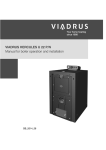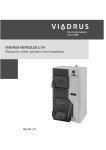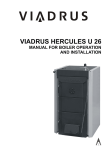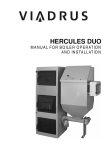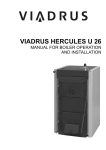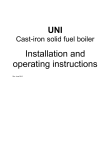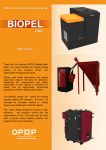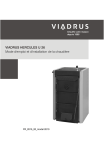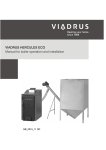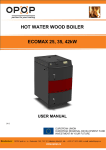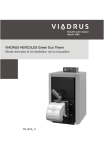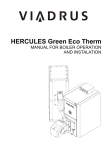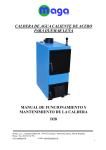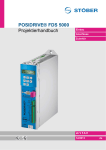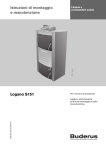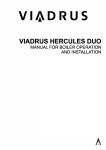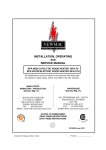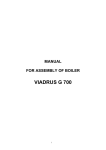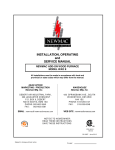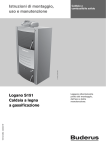Download HEFAISTOS P1 Manual for boiler operation and installation
Transcript
HEFAISTOS P1 Manual for boiler operation and installation GB_2015_10 Table of contents: 1. page Produced variants of boilers ................................................................................................................... 3 1.1 Order ................................................................................................................................................... 3 2. Technical information .............................................................................................................................. 3 2.1 The use of boiler.................................................................................................................................. 3 2.2 Advantages of boiler ........................................................................................................................... 3 2.3 Technical data of boiler Hefaistos P1 ................................................................................................. 4 2.4 The main dimensions of the boiler ...................................................................................................... 5 2.4.1 The main dimensions of the boiler Hefaistos P1 T ...................................................................... 5 2.4.2 The main dimensions of the boiler Hefaistos P1 E ...................................................................... 6 2.5 The main parts of boiler ...................................................................................................................... 7 2.5.1 The main parts of boiler Hefaistos P1 T ...................................................................................... 7 2.5.2 The main parts of boiler Hefaistos P1 E ...................................................................................... 8 3. Installation instructions ........................................................................................................................... 9 3.1 Boiler construction ............................................................................................................................... 9 3.2 Regulations and guidelines ............................................................................................................... 10 3.3 Placement options ............................................................................................................................. 11 3.4 Delivery and accessories .................................................................................................................. 13 3.4.1 Delivery and accessories - Hefaistos P1 T ................................................................................ 13 3.4.2 Delivery and accessories - Hefaistos P1 E ................................................................................ 13 3.5 Installation process............................................................................................................................ 14 3.5.1 Installing the boiler drum ............................................................................................................ 14 3.5.1.1 Installing the boiler drum – Hefaistos P1 T (see Fig. no. 8 and 9) ..................................... 14 3.5.1.2 Installing the boiler drum – Hefaistos P1 E (see Fig. no. 8 and 9) ..................................... 14 3.5.2 Mounting the control box ............................................................................................................ 18 3.5.2.1 Mounting the control box – Hefaistos P1 T (see Fig. no. 10) ............................................. 18 3.5.2.2 Mounting the control box – Hefaistos P1 E (see Fig. no. 10) ............................................. 18 3.5.3 Limit switch installation – Hefaistos P1 E .................................................................................. 20 3.5.4 Installation of cleaning tools ....................................................................................................... 20 4. Commissioning ..................................................................................................................................... 21 4.1 Control activities before starting ........................................................................................................ 21 4.2 Putting the boiler into operation ........................................................................................................ 22 4.3 Regulatory and signaling elements ................................................................................................... 23 4.3.1 Regulatory and signaling elements – Hefaistos P1 T ................................................................ 23 4.3.2 Regulatory and signaling elements – Hefaistos P1 E ................................................................ 23 4.5 Equipment to remove excess heat .................................................................................................... 24 4.6 Equipment for heat removal - storage tanks ..................................................................................... 26 4.7 Diagram of connection-boiler Hefaistos P1 ....................................................................................... 26 4.8 Electrical connection ......................................................................................................................... 28 4.8.1 Electrical connection – Hefaistos P1 T ...................................................................................... 28 4.8.2 Electrical connection – Hefaistos P1 E ...................................................................................... 30 5. Operating manual ................................................................................................................................. 32 5.1 Operation of boiler by user ................................................................................................................ 33 5.1.1 Operation of boiler by user – Hefaistos P1 T ............................................................................. 33 5.1.2 Operation of boiler by user – Hefaistos P1 E............................................................................. 35 6. Boiler cleaning - maintenance .............................................................................................................. 36 7. Fault conditions ..................................................................................................................................... 38 8. IMPORTANT NOTICES ........................................................................................................................ 39 9. Instructions for disposal of the product after its life time....................................................................... 40 10. Warranty and liability for defects........................................................................................................... 40 Dear Customer, Thank you for purchasing the pyrolytic boiler Hefaistos P1 and thus showing your confidence in the company VIADRUS a.s. Before you start to use your new product please read this manual (especially the chapter No. 5.1 Operation of boiler by user, and Chapter 8 – Important notices) so that from the beginning you get used to its proper handling. Please respect the following information, thereby ensuring a long trouble-free operation of your boiler to both your and our satisfaction. 1. Produced variants of boilers 1.1 Order Following data must be specified in the order: Order specification code HEFAISTOS P1 X X Boiler control: T: thermostatic E: electronic 2. Boiler size: 3: 3 sect. model 4: 4 sect. model 5: 5 sect. model 6: 6 sect. model 7: 7 sect. model Technical information Boiler Hefaistos P1 is a pyrolytic sectional cast-iron low pressure boiler with a metal sheet feed hopper designed for burning the lump wood. The control of boiler Hefaistos P1 T (thermostatic option) is solved by means of thermostats (in operation, flue gases and pump -see chapter 4.3.1.). Note: The thermostatic variant is used 6 – 7-sectional models. The control of boiler Hefaistos P1 E (electronic version) is solved by means of controller ST 81. Note: The electronic version is only applied to 3 – 5-sectional models. The ventilator is equipped with a probe for speed sensing. Combustion of other fuels and materials such as plastics is not permissible. 2.1 The use of boiler Three-section model of boiler Hefaistos P1 is suitable for heating the family houses. Larger sizes of the boiler meet the requirements of shops, schools, recreational facilities, weekend houses etc. The boiler is manufactured as the hot water boiler with forced heating water circulation and working overpressure up to 400 kPa (4 bar). Before the dispatch the boiler is tested for leakage by applying the test overpressure of 800 kPa (8 bar). The boiler is designed for heating both in closed and open heating systems. The boiler must be designed with one of these options of connection: storage tanks • four-way valve three-way valve • ladomat • • 2.2 1. 2. 3. 4. 5. 6. 7. Advantages of boiler High service life of cast-iron heat exchanger and all other parts due to the quality of the materials. Sophisticated manufacturing technology on automatic moulding lines with stable and proven quality of manufacturing process (ISO 9001, ISO 14001). Combustion efficiency 83 – 89%. Simple operation and maintenance. Gradation of performance according to number of sections. The version Hefaistos P1 E allows hot water preparation with the possibility to select the strategy of boiler control. Ecological operation that meets the requirements for the granting the trademark ESV (Environmentally friendly product) 3 2.3 Technical data of boiler Tab. No. 1 Dimensions, technical parameters – fuel: wood Number of sections Rated thermal output Fuel consumption at rated thermal output Fuel efficiency Feed hopper volume Burning time at rated output Flue gases temperature at outlet Flue gases mass flow at rated thermal output Efficiency Boiler class according to EN 303 – 5 Water volume Weight Combustion chamber depth Diameter of smoke throat Boiler dimensions: – height x width – depth Filling opening dimensions Maximum working water overpressure Minimum working water overpressure Testing water overpressure Boiler hydraulic losses Water side resistance of the boiler temperature difference 10K - Q - Pz Water side resistance of the boiler temperature difference 20K - Q - Pz Input water minimum temperature Water temperature control range Noise level Required draught Boiler connections – heating water – return water Cooling water temperature for equipment to remove excess heat Cooling water overpressure for equipment to remove excess heat Connecting voltage Electric input Electric coverage pcs kW -1 kg.h -1 MJ.kg l hour °C -1 g.sec % l kg mm mm mm mm mm kPa (bar) kPa (bar) kPa (bar) 3. -1 3 30 8,0 15,01 99 3 4 40 10,66 15,01 138 3 5 6 7 49,5 75 100 13,32 19,99 26,65 15,01 15,01 15,01 177 216 255 3 3 3 140 – 200 21,77 27,22 40,83 54,43 83 – 89 5 4 4 4 68,9 85 99,1 117,2 1077 702 820 959 495 636 777 918 160 200 1541 x 833 1308 1449 1794 1935 505 x 256 400 (4) 50 (0,5) 800 (8) see Fig. no. 1 16,33 4 52,9 584 354 1167 dm s 0,681 0,946 1,275 1,641 1,672 mbar 47,971 62,49 76,322 102,22 63,471 dm s 0,334 0,483 0,648 0,889 0,919 mbar °C °C dB mbar “ “ 11,282 17,56 3. -1 22,269 30,019 20,307 60 60 – 85 Does not exceed the level of 65 dB (A) 0,25 – 0,35 6/4 6/4 °C 5 – 20 kPa (bar) 200 – 600 (2 - 6) W 1/N/PE 230V AC 50 Hz TN - S 180 800 IP 40 Dependenc e of pres s ure los s on rate of flow 14000 12000 10000 pz (Pa) 8000 6000 4000 3 s ections 4 s ections 2000 5 s ections 6 s ections 7 s ections 0 0 0,2 0,4 0,6 0,8 1 1,2 Qz (10-3m3.s-1) Fig. no. 1 Hydraulic losses of boiler drum 4 1,4 1,6 1,8 2.4 The main dimensions of the boiler 2.4.1 The main dimensions of the boiler Hefaistos P1 T L Fig.no. 2 [mm] 6 998 7 1139 The main dimensions of the boiler Hefaistos P1 T 5 2.4.2 The main dimensions of the boiler Hefaistos P1 E L Fig. no. 3 [mm] 3 575 4 716 5 857 The main dimensions of the boiler Hefaistos P1 E 6 2.5 The main parts of boiler 2.5.1 The main parts of boiler Hefaistos P1 T 1 2 3 4 5 6 7 8 9 10 11 boiler drum combustion chamber lining ash pan door stoking door nozzle feed hopper lining boiler shell-left part feed hopper boiler shell-upper part control box boiler shell-rear part Fig.no. 4a) 12 13 14 15 16 17 18 19 20 21 outlet pipe exhaust ventilator boiler shell-right part smoke adaptor inlet pipe two-way safety valve DBV 1 – 02 air release valve draught controller stand boiler shell-front part Main parts of boiler Hefaistos P1 T 7 2.5.2 The main parts of boiler Hefaistos P1 E 1 2 3 4 5 6 7 8 9 10 boiler drum combustion chamber lining ash pan door stoking door nozzle feed hopper lining boiler shell-left part feed hopper boiler shell-upper part control box Fig. no. 4b) 11 12 13 14 15 16 17 18 19 20 boiler shell-rear part outlet pipe exhaust ventilator boiler shell-right part smoke adaptor inlet pipe two-way safety valve DBV 1 – 02 air release valve boiler shell-front part stand Main parts of boiler Hefaistos P1 E 8 3. Installation instructions 3.1 Boiler construction The sectional boiler drum made of grey cast iron according to EN 1561, quality 150 is the main part of the boiler. Pressure parts of boiler correspond to strength requirements according to EN 303 - 5. The boiler drum is made of sections by means of pressed boiler inserts (nipples) ø 56 mm and rubber o-rings and secured by anchor bolts. The sections create combustion space, ash pan and water spaces and also the convection part. The feed shaft consists of feed hopper, which is made of sheet metal intended for combustion processes. The upper part of the feed hopper is water-cooled. The heating water inlet and outlet are situated at the rear part of the boiler. At the rear section of the boiler there is mounted the smoke adaptor with air exchanger and exhaust ventilator. The return water connection is situated in the upper part of boiler drum. The heating water connection is situated in the upper part of the feed hopper. Water inlet and outlet can be connected by means of threaded pipes. The stoking door is mounted to the feed hopper and the ash pan door to the front boiler section. The ash pan and stoking door are made with the possibility of left-right opening (see Fig. No. 5).The whole boiler drum is insulated by using the harmless mineral insulation, which reduces the losses caused by the heat transfer to the ambient. The boiler shell is coated with high-quality comaxit spray. Fig.no. 5 Left-right opening 9 3.2 Regulations and guidelines A solid fuel boiler can only be installed by a firm holding a valid concession for boiler installation and maintenance. A project according to the valid regulations must be prepared for the installation. Before the boiler installation to an older heating system, the installation company must ensure that the whole heating system is rinsed out (washed out). The heating system must be filled with water which meets the standards that apply in the relevant country of destination requirements, especially its hardness must not exceed the required parameters. Recommended values Hardness mmol/l 2+ Ca mmol/l Concentration of total Fe + Mn mg/l *) recommended value 1 0,3 (0,3)* WARNING!!! The use of anti-freeze mixture is not recommended by the manufacturer. In case the two-way safety equipment is signalling that boiler has been filled with the water which does not meet the standards that apply in the relevant country of destination requirements it is necessary to treat the water in the system so that it again meets this standard requirements. a) To the heating system EN 303-5 Heating boilers – Part 5: Heating boilers for solid fuels, manually and automatically stoked, nominal heat output of up to 500 kW – Terminology, requirements, testing and marking b) Regarding the fire regulations EN 13501-1 + A1 Fire classification of construction products and building structures – Part 1: Classification using data from reaction to fire tests c) To the electrical network EN 60079-10 Electrical regulations. Regulations for electric equipments at the places with danger of explosion of flammable gases and vapours EN 60 335-1 ed.2 Electrical appliances for household and similar purposes – Safety – Part 1: General requirements. EN 60 335-2-102 Electrical appliances for household and similar purposes – Safety – Part 2-102: Particular requirements for appliances burning gas, oil and solid-fuel and having electrical connections. EN 60445 ed. 4 Basic and safety principles for man-machine interface, marking and identification – Identification of equipment terminals, conductor terminations and conductors 10 3.3 Placement options Boiler positioning in the living space (including corridors) is prohibited! Boiler is approved for installation in AA5/AB5 basic environment according to standards that apply in the relevant country of destination. The boiler is equipped with a movable mains supply and a plug. According to EN 60 335 – 1 ed. 2 Art. 7.12.4 the boiler must be positioned in a way so that the plug is accessible. The installation of the boiler must comply with all requirements of standards that apply in the relevant country of destination. Boiler positioning with regard to fire regulations: 1. Positioning on the floor made of incombustible material − The boiler must be installed on a fireproof bottom, which exceeds the boiler platform by 20 mm on the sides (see fig. No. 6). Number of sections L [mm] 3 Fig. No. 6 4 695 5 695 6 975 7 975 Socle dimensions 2. A safe distance from the combustible materials: − when installing and operating the boiler it is necessary to keep a safety distance of 200 mm from the materials of combustibility grade A1, A2, B and C (D); − for easily combustible materials of combustibility grade E (F), which quickly burn and burn themselves even after removal of ignition source (such as paper, cardboard, asphalt and tar paper, wood and wood-fiber boards, plastics, floor coverings) the safe distance has to be doubled, i.e. to 400 mm; − safe distance should be doubled as bulb where the grade of reaction to fire has not been proved. Tab. no. 2 Grade of reaction to fire Examples of building materials and products included in the reaction to fire (Extract from EN 13501-1 + A1) A1 – incombustible Granite, sandstone, concrete, bricks, ceramic tiles, mortars, fireproof plasters, … A2 – combustible with difficulty acumin, izumin, heraklit, lignos, boards and basalt felt, fibreglass boards,... B – hardly combustible Beech and oak wood, hobrex boards, plywood, werzalit, umakart, sirkolit,... C (D) – medium combustible Pinewood, larch, whitewood, chipboard and cork boards, rubber flooring,... Asphaltboard, fibreboards, cellulose materials, polyurethane, polystyrene, E (F) – easily combustible polyethylene, PVC,… Grade of reaction to fire 11 Location of boiler with necessary handling space: regard to − at least 1000 mm handling space must be left in front of the boiler; − the minimum distance between the rear part of the boiler and wall is 400 mm; − on both sides keep the space at least 400 mm for access to the rear part of the boiler. Fuel location: − it is forbidden to store the fuel behind or next to the boiler in a distance lower than 400 mm; − it is forbidden to store the fuel between two boilers in boiler-room; − it is recommended by the manufacturer that minimum distance of 1000 mm − is maintained between the boiler and fuel or the fuel should be stored in another room. Fig.no. 7 Location of boiler in boiler room A continuous air supply for burning and eventual ventilation must be ensured for the room where the boiler is installed. Air consumption of boiler: Number of sections Air cinsumption 3 -1 [m .h ] 3 100 4 140 5 170 6 285 7 390 The choice of the right size of boiler The choice of the right size of boiler i.e. its heat output is very important condition for economic operation and a correct function of the boiler. The boiler must be chosen so that its rated thermal output corresponds to the heat losses of the building. The rated output is calculated according to valid standards for outside temperatures –12 °C, -15 °C and –18 °C. The choice of boiler with too high rated output (oversizing) results in increased tarring and retting of the boiler. That’s why it is not suitable to use boilers with the output higher than the heat losses of the building This does not apply in case the boiler is connected in the system with a storage tank. Chimney draught The chimney with its proper draught is a fundamental prerequisite for a good function of boiler. It influences both boiler output and its efficiency. The boiler may be connected to chimney vent which has a sufficient draught (see chapter 2.3) and the revision must be carried out by an authorized organization. 12 3.4 Delivery and accessories Boiler is delivered according to the order and on the pallet there is placed the complete boiler drum plus boiler shell in a wooden casing. The accessories are inside the boiler drum and are accessible when opening the stoking door has been opened. The boiler is packed in shipping wrapping and it must not be tipped over during transport. . 3.4.1 Delivery and accessories - Hefaistos P1 T Standard boiler delivery: • • • • • • • • • • • • • • • • the boiler on the pallet in the casing with the relevant number of sections including the boiler shell cleaning kit (cleaner, hook, brush with handle, poker, dowel 2 pcs, direct hook with thread 2 pcs) complete control box with electro accessories 1 pc filling and drain valve Js 1/2“ 1 pc complete draft controller 1 pc connecting hose G 3/4“ with sealing G 3/4“ 1 pc connecting hose G 1½“ with sealing G 1½“ 1 pc T –joint G 1 ½“ 1 pc long bend G 1 ½“ 1 pc boiler plug 2 pcs adaptor reduced N4 1 ½“ x ¾“ 1 pc air release valve 1 pc ventilator (6 – 7 sect.) 1 pc manipulation key 1 pc two way safety valve DBV 1 – 02 1 pc business/technical documentation By request: • Safety valve 1 pc The boiler accessories ordered „by request“ are not included in the basic price of the boiler. 3.4.2 Delivery and accessories - Hefaistos P1 E Standard boiler delivery: • • • • • • • • • • • • • • • • • the boiler on the pallet in the casing with the relevant number of sections including the boiler shell cleaning kit (cleaner, hook, brush with handle, poker, dowel 2 pcs, direct hook with thread 2 pcs) complete control box with electro accessories 1 pc filling and drain valve Js 1/2“ 1 pc complete draft controller 1 pc connecting hose G 3/4“ with sealing G 3/4“ 1 pc connecting hose G 1½“ with sealing G 1½“ 1 pc T –joint G 1 ½“ 1 pc long bend G 1 ½“ 1 pc boiler plug 2 pcs radiator plug 1 1/2“ 1 pc sealing 1 1/2“ 1 pc air release valve 1 pc shell with ventilator (3 – 5 sect.) 1 pc manipulation key 1 pc two way safety valve DBV 1 – 02 1 pc business/technical documentation By request: • Safety valve 1 pc The boiler accessories ordered „by request“ are not included in the basic price of the boiler. 13 3.5 Installation process 3.5.1 Installing the boiler drum 3.5.1.1 Installing the boiler drum – Hefaistos P1 T (see Fig. no. 8 and 9) 1. Set the boiler drum on the socle (underlay). 2. Dismount the rear part of the shell (1) by means of 4,8 x13 screws and serrated lock washers 5,3 - see detail A and the upper part of the shell (2) according to the Figure no.8. 3. Install T- joint (13), the reduced adaptor (16) into T- joint, then mount the long bend (12) and the interconnection pipe G 1 ½“ (14) via sealing 1 ½“ according to the Fig. no.9a. 4. Install the outlet pipe. Install the air-release valve (10) and two-way safety valve DBV 1 – 02 (8) to the heating water outlet (6) (see Fig. no. 9a, 14, 15) – the valve can be installed only in the horizontal position. The heating water outlet pipe (6) must be connected via a demountable joint to the heating system. 5. The return water inlet (3) must be connected via a demountable joint to the heating system. 6. Install the filling and drain valve G 1/2“ (1). 7. Install the control box see chap. no. 3.5.2. 8. Screw the draft controller (15) into the opening in the reduced adaptor (16). The procedure of setting the boiler draft controller is shown in chapter no.5.1.1-Operation. 9. Put the smoke pipe on the exhaust ventilator (2) and push it into the chimney hole. The smoke pipe diameter is stated in tab. No.1. 3.5.1.2 Installing the boiler drum – Hefaistos P1 E (see Fig. no. 8 and 9) 1. Set the boiler drum on the socle (underlay). 2. Dismount the rear part of the shell (1) by means of 4,8 x13 screws and serrated lock washers 5,3 - see detail A and the upper part of the shell (2) according to the Figure no.8. 3. Install T- joint (13), the radiator plug (15) into T- joint, then mount the long bend (12) and the interconnection pipe G 1 ½“ (14) via sealing 1 ½“ according to the Fig. no.9b. 4. Install the outlet pipe. Install the air-release valve (10) and two-way safety valve DBV 1 – 02 (8) to the heating water outlet (6) (see Fig. no. 9b, 14, 15) – the valve can be installed only in the horizontal position. The heating water outlet pipe (6) must be connected via a demountable joint to the heating system. 5. The return water inlet (3) must be connected via a demountable joint to the heating system. 6. Install the filling and drain valve G 1/2“ (1). 7. Install the control box see chap. no. 3.5.2. 8. Put the smoke pipe on the exhaust ventilator (2) and push it into the chimney hole. The smoke pipe diameter is stated in tab. No.1 14 1. boiler shell-rear part 2. boiler shell-front part 3. boiler shell-upper part Fig.no. 8 Dismantling of the upper rear part of the boiler shell 15 1 2 3 4 5 6 7 8 filling and drain valve G 1/2“ shell with ventilator return water input (with distribution pipe) boiler plug 1/2“ sleeve 1 1/2“ heating water output boiler plug 1/2“ two-way safety valve DBV 1 – 02 Fig.no. 9a) 9 10 11 12 13 14 15 16 interconnecting hose 3/4“ air-release valve 1/2“ pipe-output long bend 1 1/2“ T-joint 1 1/2“ interconnecting hose 1 1/2“ draught controller adaptor reduced 1 1/2“ na 3/4“ Installing the boiler drum – Hefaistos P1 T 16 1. 2. 3. 4. 5. 6. 7. 8. filling and drain valve G 1/2“ shell with ventilator return water input (with distribution pipe) boiler plug 1/2“ sleeve 1 1/2“ heating water output boiler plug 1/2“ two-way safety valve DBV 1 – 02 Fig.no. 9b) 9. 10. 11. 12. 13. 14. 15. 16. interconnecting hose 3/4“ air-release valve 1/2“ pipe-output long bend 1 1/2“ T-joint 1 1/2“ interconnecting hose 1 1/2“ radiator plug 1 1/2“ sealing 1 1/2“ Installing the boiler drum – Hefaistos P1 E 17 3.5.2 Mounting the control box 3.5.2.1 Mounting the control box – Hefaistos P1 T (see Fig. no. 10) 1. Dismount the upper part of the control box (3) by means of 2 screws M5 x 12 and serrated lock washers 5,3 – see detail B. Thread the capillaries of the control box thermostats through the opening in the upper part of the shell and by means of 2 pc screws M5 x 25 and serrated lock washers 5,3 screw the control box to the upper front part of the shell (4) – see detail A. 2. Put the upper part of the shell (4) on the side parts of the shell (1, 2): - Insert the flue gas thermostat capillary into the smoke adaptor basin; - screw the manometer capillary into the check valve and insert the capillaries of thermometer and thermostats into the basin in the water space of the feed hopper and secure by the spring of capillaries. 3. In the upper part of the boiler shell (5) break out a perforated opening either on the right or left side, depending on the need. Install the bushing ICOTEK. 4. Carry out the wiring (see chap. 4.8). It is necessary to ensure that the wiring and capillaries do not directly touch the feed hopper. 5. Insert the front upper part of shell (4) and upper part of the shell (5) on the side parts of the shell (1, 2). 6. Screw the rear part of the shell (6) to the upper (5) and side parts of the shell (1, 2) by means of 11 pc screws C 4,8 x13 and serrated lock washers 5,3 – see detail B. 3.5.2.2 Mounting the control box – Hefaistos P1 E (see Fig. no. 10) 1. Install the limit switch see chap. 3.5.3. 2. Dismount the upper part of the control box (3) by means of 2 screws M5 x 12 and serrated lock washers 5,3 – see detail B. Thread the capillaries of the control box thermostats through the opening in the upper part of the shell and by means of 2 pc screws M5 x 25 and serrated lock washers 5,3 screw the control box to the upper front part of the shell (4)- see detail A. 3. Put the upper part of the shell (4) on the side parts of the shell (1, 2): - Insert the flue gas thermostat capillary into the smoke adaptor basin; - Screw the manometer capillary into the check valve and insert the capillary of safety thermostat and the sensor of boiler water output temeperature (ÚT) into the basin in water space of the feed hopper and secure by the spring of capillaries. 4. In the upper part of the boiler shell (5) break out a perforated opening either on the right or left side, depending on the need.Install the bushing ICOTEK. 5. Carry out the wiring (see chap.4.8). Put the sensor of flue gases temperature on the flue gas ducting and secure by means of a self-drilling screw in the distance 3 x D (diameter of the the flue gas ducting) from the shell of ventilator. It is necessary to ensure that the wiring and capillaries do not directly touch the feed hopper. 6. Insert the front upper part of shell (4) and upper part of the shell (5) on the side parts of the shell (1, 2). 7. Screw the rear part of the shell (6) to the upper (5) and side parts of the shell (1, 2) by means of 11 pc screws C 4,8 x13. and serrated lock washers 5,3 – see detail B. 18 1 2 3 4 5 6 left side part of shell with insulation right side part of shell upper part of the control box upper front part of the shell upper part of the shell rear part of the shell A B Fig. no. 10 Mounting the control box to the upper part of the shell Mounting the upper part of the control box Mounting the control box 19 3.5.3 Limit switch installation – Hefaistos P1 E 1. 2. 3. 4. Connect the limit switch according to the electrical connection see. Chap. 4.8 Insert the rod (9) into the left hole (A) in consoles (2). Then mount the circlip 7 (8). By means of screws M4 x 40 (4) and washers 4.3 (6) mount the limit switch (3) to the consoles (2) and the upper part of shell (1) and secure with nuts M4 (7) and washers 4.3 (6). Screw the bolt M5x 20 (11) with washers 5.3 (10) on the rod (9) in the front upper part of the shell (if necessary- when testing the limit switch- we can change the number of washers (10). A – left hole of the console 1. upper part of the shell 2. console 3. limit switch 4. screw M 4 x 40 5. washer 4,3 6. 7. 8. 9. 10. 11. Fig. no. 11 washer 4,3 nut M4 console rod washer 5,3 screw M 5 x 20 Limit switch installation 3.5.4 Installation of cleaning tools Use the common assembly tools and leather gloves when mounting or dismounting the brush, tip on the spike and cleaner (if included in the delivery). 20 4. Commissioning Putting the boiler into operation can be performed only by professional installation companies authorized to carry out this work. . 4.1 Control activities before starting Before putting the boiler into operation it is necessary to check: 1. Filling the heating system with water (inspection of the thermomanometer) and the tightness of the system. Heating system must be thoroughly rinsed out in order to wash out all impurities that might be deposited in piping or radiators and consequently would cause damage to the pump. Water for filling the boiler and heating system must be clear and colourless, without any suspended substances, oil and chemically aggressive substances. Its hardness must comply with standards that apply in the relevant country of destination and in case of dissatisfactory hardness the water must be treated. Even a repeated heating of water with a higher hardness does not prevent the salts from segregation on the walls of boiler drum. By precipitation of 1 mm calcite at a given point the heat transfer from metal to water is reduced by 10 %.The heating systems with an open expansion tank allow a direct contact between the heating water and the atmosphere. During the heating season the expanding water in the reservoir absorbs the oxygen which increases the corrosive effects and at the same time lot of water evaporates. Only the water treated to the values according to standards that apply in the relevant country of destination can be used for refilling. During the heating season it is necessary to maintain a constant water volume in the heating system. When refilling the water in the heating system it is necessary to ensure that no air is sucked into the system. The water from boiler and the heating system must never be discharged or be used except the emergency cases like the repairs, etc. By emptying the boiler and filling it with new water the danger of corrosion and the scaling is increased. If it is necessary to refill water in the heating system, we only do it when the boiler has cooled down so that the heat exchanger cannot be damaged. 2. Connection to the chimney - this connection can be made only with the consent of the competent chimney company (revision of chimney). 3. Connection of the two-way safety valve DBV 1 – 02. 4. Connection to electrical network. 5. Tightness of the stoking door and ash pan doors: Approximately in the middle of sealing cord there must be about 2 mm groove (see Fig. no. 12-12, 13) uniformly along the whole circumference as the imprint of the sealing surface. If there is no groove in the sealing cord the door should be adjusted. The untightness can be removed both on the side of handle and on the side of hinges. On the side of hinges there must be dismounted the side shell and the eyes of hinges must be adjusted by means of nuts M 16. Tightening of the handle (see Fig.no. 12) is carried out as follows: • loosen the screws of handle (9) and remove the handle (3) • loosen the locking nuts (5) • loosen the set screw (6) as required • put on the handle (3) and secure with locking screws (9) • close the door • tighten the set screw (6) • loosen the locking screws (9) • remove the handle (3) and tighten the nuts (5) • put on the handle (3) and secure with screws (9). Slumping or otherwise misaligned door can be centered by loosening the door hinges: • in case of stoking door by releasing three bolts M 10 the inside the door at hinges. • in case of ash pan door by releasing the hinges after dismantling the front shell. 21 1. 2. 3. 4. 5. 6. 7. Closing Axis of handle Handle Flexible circlip Securing nut Washer Setscrew Fig.no. 12 4.2 8. 9. 10. 11. 12. 13. Blind flange Locking screw of the handle Locking screw of closing Counterpart of closing Sealing cord Sealing surface of feed hopper Setting of the handle of ash pan door and stoking door Putting the boiler into operation 1. Make a fire in boiler 2. Bring the boiler to the necessary operating temperature. The recommended temperature of the output water is 80 °C. 3. Switch on the exhaust ventilator 4. Check the functionality of two way safety valve DBV 1 – 02 5. Operate the boiler in operating state according to appropriate standards. 6. Check again the boiler for leakage 7. Make the user acquainted with operation and maintenance 8. Make a record in the Guarantee certificate. 22 4.3 Regulatory and signaling elements 4.3.1 Regulatory and signaling elements – Hefaistos P1 T Combustion air is brought to boiler by means of a throttle valve (choking valve), which is placed on the smoke adaptor. By means of the air exchanger the combustion air will be distributed to the nozzle as the primary air and into lining of combustion chamber as the secondary combustion air and both are controlled by draft controller. Thermomanometer – is used for measuring the water temperature and pressure in boiler. Flue gases thermoregulator (range 0 – 300 °C) – serves for switching off the ventilator after the fuel has burnt out. When making a fire in boiler we set the flue gases thermoregulator to „minimum“– 0 °C. In the stage of flaring we set the flue gases thermoregulator to operating temperature, which is to be set by user. It is necessary to find the right value so that the ventilator will switch off after the fuel has burnt out. If the flue gases temperature drops below the set value, the thermo-regulator will switch off the exhaust ventilator If we want to make the ventilator work again, we have to set the flue gases thermoregulator to lower temperature. Operating thermoregulator – controls the run of ventilator depending on the outlet water temperature. Safety thermoregulator (irreversible) – serves as a protection against boiler overheating. It is set to 95 °C. In case of a fault it is necessary- after the boiler has cooled down- to deactivate the safety thermoregulator manually. Due to the activation of safety thermoregulator the exhaust ventilator is switched off and it is signalled by a orange pilot light on the control box panel. Thermoregulator of the pump– is used for setting the temperature when the pump is switched on (we recommend setting to 50 – 55 °C). Draught controller– serves for the control of throttle valve (choking valve) which is installed on the smoke adaptor of the boiler. 1 – Termomanometer 2 – Signalling the safety thermoregulator 3 – Signalling the run ov ventilator 4 – Circuit breaker Fig. no. 13a) 5 – Operating thermoregulator 6 – Flue gases thermoregulator 7 – Safety thermoregulator 8 – Thermoregulator of the pump Control box – Hefaistos P1 T 4.3.2 Regulatory and signaling elements – Hefaistos P1 E Combustion air is brought to boiler by means of a throttle valve (choking valve), which is placed on the smoke adaptor. By means of the air exchanger the combustion air will be distributed to the nozzle as the primary air and into lining of combustion chamber as the secondary combustion air and both are controlled by draft controller. Thermomanometer – is used for measuring the water temperature and pressure in boiler. Safety thermoregulator (irreversible) – serves as a protection against boiler overheating. It is set to 95 °C. In case of a fault it is necessary- after the boiler has cooled down- to deactivate the safety thermoregulator manually. Due to the activation of safety thermoregulator the exhaust ventilator is switched off and it is signalled by a orange pilot light on the control box panel. Controller ST 81 processes data from sensors of output water temperature, hot water and flue gases temperature. According to the data in this way the modulated exhaust ventilator, central heating pumps and HW (hot water) pumps are controlled. Limit switch of stoking door every time you open the stoking door (opening the limit switch) the exhaust ventilator is activated at its maximum power and thus prevents the escape of flue gases into the space where the boiler is located. After closing the stoking door (closing the limit switch) the fan power returns into automatic mode. 23 Flap of throttle valve (choking valve) - opens automatically when fan is running. When you stop the fan the flap is closed by means of counterweight. The weights should be adjusted so that the flap at full fan power is opened to about 45 °. 1 – Manometer 2 – Signalling of the safety thermoregulator 3 – Controller ST – 81 Fig.no. 13b) 4.5 4 – Circuit breaker 5 – Safety thermoregulator Control box with regulator ST – 81 – Hefaistos P1 E Equipment to remove excess heat The two way safety valve DBV 1 - 02 is used for surplus heat removal in case the water temperature in boiler exceeds 95 °C. In case the system is equipped with a two- way safety valve DBV 1 – 02 and it comes to the boiler overheating (the outlet water temperature is above 95 °C) then two-way safety valve will create a cold water circuit until the temperature drops below the limit temperature. At this moment there is closed the draining cooling system and the inlet of cold water inlet used for refilling the system. A – cold water inlet B – outlet to the boiler C – outlet to the waste D – inlet from the boiler . Fig.no. 14 Two-way safety valve DBV 1 – 02 Technical data on the two-way safety valve DBV 1 – 02 (made by Regulus) Opening temperature (limit): Maximum temperature: Maximum pressure on the boiler side: Maximum pressure on the water side: Nominal flow at p 100 kPa (1 bar): 100 °C (+0° - 5 °C) 120 °C 400 kPa (4 bar) 600 kPa (6 bar) 3 1,9 m /h 24 Usage The two way safety valve DBV 1 – 02 is used as a protection of heating boilers against overheating. In the valve body there is the drain and filling valve controlled by a thermostatic member. When the limit temperature is reached both the drain and filling valve are opened which means that cold water is flowing into boiler and the hot water is discharged. When the temperature drops below limit, both the drain and filling valve are closed simultaneously. Caution! It is not a compensation for safety valve In case the two-way safety equipment is signalling that boiler has been filled with the water which does not meet the standards that apply in the relevant country of destination requirements it is necessary to treat the water in the system so that it again meets this standard requirements. 1 – Boiler 2 – Two-way safety valve DBV 1 – 02 3 – Safety valve 4 – Reduction valve 5 – Filter 6 – Ball valve Fig.no. 15 7 – Pump 8 – Outlet of of excess heat 9 – Drain valve I – Cold water input II – Heating water output III – Return water input Recommended diagram of connection of two-way safety valve DBV 1 - 02 Installation The installation can be only carried out by a qualified person. For the correct operation of the thermostatic two-way safety valve it is necessary to comply with the conditions stipulated for its installation and observe the flow directions indicated on its body. The safety valve is alway mounted in the output pipe of boiler or directly on the upper part of boiler where the hot water leaves boiler and is transported into heating system. When installing the valve it is necessary to check whether the use of the 3/4“ sleeve, which can be both in pipeline and on boiler ensures a complete immersion of the thermostatic member of valve after the valve installation. After the installation in the sleeve the waste piping will be connected in the point “C" (see. fig. No. 14) and it leads the hot water from boiler into the sewer. In point "A" (see. fig. No.14) there the cooling water inlet is connected (Fig. no.15) and this water will ensure cooling of oiler after setting the valve into operation.At the cooling water inlet there must be installed the filter for capture of mechanical impurities. In the point “B” (see Fig. no.14) there is connected the piping which according to Fig. no.15 is led into the return pipe of heating system near the boiler. Regular maintenance Once a year it is necessary to turn the head of the safety valve to remove possible impurities settled in the valve. Clean the filter in the inlet of cooling water. Important It is not possible to turn the flows and that’s why it is important to observe markings of filling and draining as indicated on the valve. 25 4.6 Equipment for heat removal - storage tanks We require the connection of pyrolytic boiler with storage tanks. Advantages: • A lower fuel consumption (by 20 – 30 %), the boiler is working at full power and optimal efficiency till the fuel has burnt out • Long service life of boiler and chimney – minimum production of tars and acids • Combination of heating elements and floor heating • More comfortable heating • Ecological heating • Possibility of combination with other types of heating The calculation of the stack exchanger lowest volume Vsp = 15Tb x QN (1-0,3 x (QH/Qmin) where: Vsp QN Tb QH Qmin storage tank volume (liters) rated thermal output (kW) burning time (hrs) heat load of buildings (kW) the lowest heat output (kW) Dimensions of storage tanks for central heating boilers that are operated with the individual stipulated fuels must be determined according to output which must have the biggest storage tank. In case of a storage container usage, the boiler can be fired or stoked up again, if the boiler is burned down to the fire basis, and the storage container is empty or cool. ATTENTION! Ignoring leads to extreme heat exchanger fouling. 4.7 Diagram of connection-boiler Fig.no. 16 Recommended diagram of the boiler connected with a four-way mixing valve 26 Fig.no. 17 Recommended diagram of the boiler connected with a three-way mixing valve HW Fig.no.18 Recommended diagram of the boiler connected with a storage tank Legend to Fig. no. 16 – 18: 1 – Boiler 2 – Safety valve 3 – Reservoir of hot water (TV) 4 – Pump 5 – Heating system 6 – Four-way mixing valve 7 – Clack valve 8 – Expansion tank 9 – Storage tank 10 – Three-way valve controlled by a higher-level regulation 11 – Valve 12 – Heating circuit pump controlled by a higher-level regulation 13 – Thermo valve or ladomat 14 – Charging pump of HW tank controlled by HW tank thermoregulator, HW sensor or higher-level regulation 27 CONTACTOR OF EXHAUST VENTILATOR EXHAUST VENTILATOR PUMP TERMINAL BOARD OF BOILER CONNECTOR OF VENTILATOR (SOCKET) CONNECTOR OF VENTILATOR (PLUG) SUPPRESSION COMPONENT Electrical connection Circuit diagram of connection - boiler Hefaistos P1 T K1 MV1 Q1 X1 X10 X10.1 Z1 4.8 4.8.1 Electrical connection – Hefaistos P1 T Fig.no. 19 28 LEGEND: BT1 SAFETY THERMOREGULATOR BT3 FLUE GASES THERMOREGULATOR BT2 OPERATINGÍ THERMOREGULATOR BT4 PUMP THERMOREGULATOR F1 FUSE 6,3 A H1 SIGNALLING THE RUN OF VENTILATOR (GREEN) H2 SIGNALLING THE SAFETY THERMOREGULATOR (ORANGE) FEED HOPPER DISTRIBUTION BOX LEGEND: BT1 SAFETY THERMOREGULATOR BT3 GLUE GASES THERMOREGULATOR SPALIN BT2 OPERATING THERMOREGULATOR BT4 PUMP THERMOREGULATOR F1 FUSE 6,3 A H1 SIGNALLING THE RUN OF VENTILATOR (GREEN) H2 SIGNALLING THE SAFETYHO THERMOREGULATOR (ORANGE) K1 CONTACTOR OF EXHAUST VENTILATOR MV1 EXHAUST VENTILATOR Q1 PUMP X1 TERMINAL BOARD OF BOILER X10 CONNECTOR OF VENTILATOR (SOCKET) X10.1 CONNECTOR OF VENTILATOR (PLUG) Z1 SUPPRESSION COMPONENT Fig.no. 20 Wire colour GNYE green yellow GN green YE yellow RD red BK black BN brown BU blue Diagram of connection- boiler Hefaistos P1 T 29 4.8.2 Electrical connection – Hefaistos P1 E Fig.no. 21 Circuit diagram of connection - boiler Hefaistos P1 E 30 LEGEND: A2 MODULE TECH ST 68 ČO SPEED SENSOR MV1 MV1 EXHAUST VENTILATOR BT1 SAFETY THERMOREGULATOR H1 SIGNALLING BT1 X1 TERMINAL BOARD OF SUPPLY X2 CONNECTOR ST 81 DO ST 68 F1 FUSE 6,3 A A1 CONTROLLER TECH ST 81 Q3 PUMP OF HW (HOT WATER) Q1 PUMP OF ÚT (CENTRAL HEATING) S10 LIMIT SWITCH OF STOKING DOOR B1 BOILER TEMPERATURE SENSOR B2 FLUE GASES TEMPERATURE SENSOR B3 HOT WATER TEMPERATURE SENSOR Wire colour GNYE green yellow GN green YE yellow RD red BK black BN brown BU blue UPPER PART BOILER DRUM DISTRIBUTION BOX Fig.no. 22 Diagram of connection - boiler Hefaistos P1 E 31 LEGEND: A2 MODULE ST 68 HALL SPEED SENSOR MV1 MV1 EXHAUST VENTILATOR BT1 SAFETY THERMOREGULATOR H1 SIGNALLING BT1 X1 TERMINAL BOARD OF SUPPLY X2 CONNECTOR ST 81 DO ST 68 X3 TERMINAL BOARD HALL F1 FUSE 6,3 A A1 Q3 Q1 S10 B1 B2 B3 X10 X10.1 CONTROLLER TECH ST 81 PUMP OF HW (HOT WATER) PUMP OF ÚT (CENTRAL HEATINGÍ) LIMIT SWITCH OF STOKING DOOR BOILER TEMPERATURE SENSOR FLUE GASES TEMPERATURE SENSOR HOT WATER TEMPERATURE SENSOR SOCKET FOR MV1 PLUG FOR MV1 5. Operating manual Incorrect operation and improper combustion of fuel leads to damage to the product. During the first ignition of the cold boiler, water condenses therein and then flows down its inner walls. This condensation of the boiler body ends when the boiler reaches operating temperature. During the operation of the boiler at the temperature lower than 60°C, condensing of water on the boiler body or the so called low temperature corrosion can take, which shortens the life of the boiler exchanger. Therefore we recommend to operate the boiler at 60°C and higher. WOOD Dry split wood logs from 80 to 150 mm. Length according to Table 3 Tab. No. 3 Length of logs počet článků 3 4 L mm] 330 470 5 610 6 750 7 890 Calorific value 15 – 17 MJ /kg Moisture 12 – 20 % Guarantee of clean and good combustion is to use only dry and wood in the natural state. It is necessary to keep the wood max. humidity 20%. If the humidity is higher than 20%, output of the boiler decreases. Combustion of the damp wood releases water which condenses on the walls of the boiler and chimney body, this leads to an increased formation of tar and water vapor, which reduces the life of the heat exchanger. Additionally, improper combustion leads to arising of aggressive substances, which cause decrease of wall thickness on the heat transfer surfaces, which can also be the reason of the exchanger perforation. Fuel must be stored in a dry place. For heating, do not use plastics, household waste, chemically treated wood residues, waste paper, wood chips, brushwood, garbage from boards pressed from the bark or chipboards. ▶ ▶ ▶ Follow the instructions for operating the boiler. When operating the boiler follow the recommended operating temperature. Operate the boiler with an approved fuel. When burning the wet wood the boiler does not work in the gasification regime, its output is reduced and emissions are worse and there occurs the flue gases condensation in the boiler. Consequently the boiler and chimney service life are shorter. Fig.no. 23 Location of fuel in the boiler 32 5.1 Operation of boiler by user 5.1.1 Operation of boiler by user – Hefaistos P1 T Making a fire (firing) 1. 2. 3. 4. 5. 6. 7. 8. 9. 10. 11. Check the water quantity in the heating system indicated on the thermo-manometer Open the stop valves between boiler and heating system Clean the boiler drum and smoke pathways see chapter 6 The flue gases ventilator must not be working Open the throttle valve (choking valve) Insert kindling through the stoking door – dry, smaller wood chips upright on the duct (it is necessary to pay attention to flue gases flow continuity), then paper and bigger wood chips Ignite the kindling in the feed hopper Close the stoking door Set the flue gases thermoregulator to 0°C and operating thermo-regulator to operating temperature (recommended working temperature is 800°C). This will switch on the flue gases ventilator. Let the kindling flare. Close the throttle valve and hold the stoking door ajar, wait approx. 10 seconds before you open it fully and then fill the whole volume of feed hopper with fuel. Close the stoking door and open the throttle valve. Operation o 1. Heat the boiler to 80 C. Set the draught controller to the temperature read on the boiler thermometer. 2. Set the chain of draught controller to the required output, which is at the throttle valve approx. 3 – 50 mm. With a lower air volume the boiler output is reduced. Due to the boiler tarring make sure that the throttle valve is never fully closed (it always must be open up to 3 mm by means of the setscrew of the throttle valve (Fig. no. 24). o 3. During the operation the draft controller temperature must be set approx. 5 C higher than the temperature set on operating thermoregulator. 4. During operation it is necessary to feed the boiler with fuel according to the combustion intensity and need of heat. CAUTION! When refilling the fuel close the throttle valve and hold the stoking door ajar, wait approx. 10 seconds before you open it fully and then fill the whole feed hopper with fuel. Close the stoking door and open the throttle valve. 5. The boiler working with its full output (2 - 4 stokings) is able to heat up the storage tank volume to temperature between 80- 90 °C and then we let the boiler burn out. Then we only take heat from storage tank by means of three-way valve for the duration that corresponds to the size of the storage tanks. 33 Fig. No. 24 The throttle valve held ajar at 3 mm by means of setscrew Top-fed operation The top-fed operation can only be used in winter season due to reduction of boiler service life. At the top-fed operation the combustion process holds more than 12 hours. Boiler preparation for the top-fed operation: 1. Replenish the fuel on the glowing layer in the whole volume of the feed hopper. 2. At this operation it is necessary to keep the water temperature 80 – 90 °C. This temperature is achieved by closing the mixing valve (the ventilator is switched off by the boiler thermoregulator and the boiler throttle valve is closed). 34 5.1.2 Operation of boiler by user – Hefaistos P1 E User guide for controller ST 81 is delivered separately. Making a fire 1. 2. 3. 4. Check the water quantity in the heating system indicated on the thermo-manometer. Open the stop valves between boiler and heating system. Clean the boiler drum and smoke pathways see chapter 6. Insert kindling on the nozzle through the stoking door – dry, smaller wood chips upright on the duct (it is necessary to pay attention to flue gases flow continuity), then paper and bigger wood chips. 5. Ignite the kindling in the feed hopper. 6. Close the stoking door. 7. Connect the controller ST 81 to the electricity mains, switch on (position 1 of the switch). By pressing the Ignition Manual work appears on the display. By the next pressing the button button we make a fire (ventilator is activated). 8. Let the kindling flare. 9. Hold the stoking door ajar, wait approx. 10 seconds before you open it fully and then fill the whole feed hopper with fuel. Close the stoking door. 10. If the temperature of output water exceeds the set production value of 40 °C within 30 minutes the boiler ignition and its transfer into automatic mode have been successful. Otherwise, repeat the whole process. Operation 1. Set the required output boiler temperature of (60 – 85 °C, 80 °C is recommended by the manufacturer). 2. During operation it is necessary to feed the boiler with fuel according to the combustion intensity and need of heat. CAUTION! When refilling the fuel close hold the stoking door ajar, wait approx. 10 seconds before you open it fully and then fill the whole feed hopper with fuel. Close the stoking door. 3. The boiler working with its full output (2 - 4 stokings) is able to heat up the storage tank volume to temperature between 80 – 85 °C and then we let the boiler burn out. Then we only take heat from storage tank by means of three-way valve for the duration that corresponds to the size of the storage tanks. Top-fed operation The top-fed operation can only be used in winter season due to reduction of boiler service life. At the top-fed operation the combustion process holds more than 12 hours. Boiler preparation for the top-fed operation: 1. Replenish the fuel on the glowing layer in the whole volume of the feed hopper. 2. At this operation it is necessary to keep the water temperature 80 – 90 oC. This temperature is achieved by closing the mixing valve (the ventilator is switched off by the controller) 35 6. Boiler cleaning - maintenance ATTENTION! 1. 2. 3. 4. 5. 6. Carry out the cleaning exclusively before making fire(firing) and when the combustion chamber is cold. Remove ashes from the combustion chamber and feed hopper. This must be done before every firing and once a week in case of top-fed stove operation. Or it must be cleaned as soon as by the visual control it is indicated that the level of ashes has reached the openings in the back side of the combustion chamber. The the nozzle and lining are not removed during cleaning. The cleaning of smoke ducts is done depending on the ash deposits on them. It is necessary to put ash into fire resistant bins with lids. At this work it is necessary to use protective tools and pay attention to personal safety. Smoke adaptor cleaning according to fig. No 25. At the end of heating season it is necessary to clean smoke drafts of boiler and fan circulation wheel. At the end of heating season clean the door swivel pins of all doors 1 – Smoke adapter 2 – Insulation of cleaning cover of smoke adapter 3 – Cleaning cover of smoke adapter 4 – Hexagon nut M6 with washer 6 Fig.no. 25 Cleaning of the smoke adapter 36 Cleaning of boiler drum and combustion space (see Fig. no. 26): Firstly switch on the exhaust ventilator, then open the stoking door and through the slot sweep ashes into combustion chamber of the boiler drum. By means of a cleaner remove ashes and unburnt pieces of fuel from the combustion chamber. Clean the boiler drum vent holes by means of a brush. Brush of polyamide can not be used at higher temperatures (cleaning must be done only at the cold boiler drum) Clean (sweep) the internal part of door –remove the ash and soot 1 – Boiler drum 2 – Combustion chamber 3 – Cleaner 4 – Brush 5 – Stoking door 6 – Vent holes of the boiler drum Fig.no. 26 Cleaning of the boiler drum and combustion chamber 37 7. Fault conditions Fault conditions Cause Remedy The boiler output is too low Calorific value of fuel is insufficient fuel moisture is above 20% Clogged or deformed fan propeller Reverse fan revolutions Clogged nozzle Operating conditions not observed An excessive amount of condensate in the stoking space of boiler Improper or too moist fuel Low temperature of boiler water Flue gases fan does not rotate or it is too noisy Attention! Standing fan may cause incomplete combustion and formation of tar deposits Only at standing fan: maximum temperature of the boiler is reached Use the prescribed fuel of prescribed moisture Clean the fan propeller or replace it Check direction of fan revolutions Clean the nozzle orifice with poker Check the transport pressure, temperature of reverse flow Use prescribed or dry fuel Check / increase the minimum boiler water temperature on the controlling device and by adjusting the mixing valve ensure the minimum temperature 60 ˚C in reverse flow No fault has occurred! The boiler is working properly. The flue gases fan starts when you open the stoking door. Too much fuel is loaded. Have the fan or capacitor replaced by a specialist company. Remove tar deposits from the fan propeller and if a damage is detected replace the fan propeller Adjust the limit switch of stoking door or have it replaced by a specialist company The fan motor or starting capacitor are defective Propeller of fan is baked The limit switch of stoking door is in a wrong position or is defective 38 8. IMPORTANT NOTICES 1. The boiler only can be used for the purposes that it is destined for. 2. The boiler only can be operated by adults who are made acquainted with this operation manual. It is not permitted to let the children unattended by adults near the boiler being in operation. It is not permitted to tamper with boiler in a way, which could endanger operators or eventually roommates’ health. 3. The boiler is not destined for the use by persons (incl. children) whose physical, sensual or mental disability or lack of experience and knowledge prevent them from a safe use of the appliance unless they are supervised or if they were not instructed on the use of appliance by a person responsible for their safety. 4. Children should be supervised in order to ensure that they do not play with the appliance. 5. If there occurs a danger of combustible vapors or gases that are releasing and penetrating into the boiler room or when working in a temporary fire or explosion risk (gluing the floorings, painting works using the combustible paints etc.) the boiler must be well ahead put out of operation before these works start. 6. It is forbidden to use the flammable liquids for firing the boiler. 7. It is FORBIDDEN to overheat the boiler during its operation. 8. Open the stoking door and ash pan door only by means of plastic handles 9. The ash pan door must not be opened during boiler operation 10. The flammable subjects mustn’t be laid on the boiler or in a distance lower than the safety distance. 11. The flammable materials must be in a distance at least 1500 mm from the boiler when clearing ashes from boiler. 12. When operating the boiler at the temperature lower than 60 °C there can appear the retting of boiler and so called low-temperature corrosion which can reduce the boiler drum service life. Therefore it is recommended to operate the boiler at temperature 60 °C and higher. 13. In case of a storage container usage, the boiler can be fired or stoked up again, if the boiler is burned down to the fire basis, and the storage container is empty or cool. ATTENTION! Ignoring leads to extreme heat exchanger fouling. 14. After the end of heating season the boiler including the smoke flues and smoke adapters must be thoroughly cleaned. The swivel pins, smoke flap mechanism and other moving parts of boiler must be lubricated by applying the graphite grease. Keep the boiler room clean and dry. 15. If the boiler is not in use (e.g. in summer season ) it is necessary to disconnect it from the electrical power network due to possible damage caused by the atmospheric surge (lightning)! 16. The possible signs of corrosion on the boiler drum are not any defects and do not influence its function. 17. In case the two-way safety equipment is signalling that boiler has been filled with the water which does not meet the standards that apply in the relevant country of destination requirements it is necessary to treat the water in the system so that it again meets this standard requirements. 18. During assembly, installation and operation of the appliance it is necessary to comply with standards that apply in the relevant country of destination. If you fail to meet these conditions you cannot requisite the guarantee repairs. 39 9. Instructions for disposal of the product after its life time VIADRUS a.s. is a contracting partner of the firm EKO–KOM a.s. with the client number F00120649. The packing complies with EN 13427. We recommend disposing the packing in the following way: plastic foil, cardboard cover: use a collection point for waste materials metal strapping tape, use a collection point for waste materials wooden base, is designated for a single usage and no longer can be used as a product. Its disposal is subject to Act. 477/2001 Coll. and 185/2001 Coll. as amended. Because the boiler is constructed from common materials, we recommend disposing the individual parts as follows: the heat exchanger (grey cast-iron), use a collection point for waste materials distribution pipes, shell, use a collection point for waste materials other metal parts, use a collection point for waste materials insulation material ROTAFLEX, through a firm engaged in collection and disposal of waste. In case that the product has lost its utility properties you can use the taking back service (if this is introduced). If the originator has declared that it regards the waste it will be handled according to the legislative provisions valid in the particular country. 10. Warranty and liability for defects VIADRUS a.s. provides the guarantee: – for the boiler during 24 months after it was put into operation, but at the most 30 months after it was dispatched from the VIADRUS a.s.; – for the boiler drum during 5 years after it was dispatched from the VIADRUS a.s. For a possible complaint the customer is obliged to show the packaging label of the boiler shell. It is placed on cardboard in which the shell is dispatched. The user is obliged to entrust a specialist installation company with boiler commissioning and and with removal of faults only a specialist contractual service accredited by VIADRUS a.s., otherwise the guarantee for boiler proper function does not apply. The „Certificate of Hefaistos P1 boiler quality and completeness” after having been filled serves as the „Guarantee certificate” The user is obliged to do a regular maintenance on the boiler. Every defect must be announced immediately after it has been discovered, namely in a written form and via a telephonic agreement. In case the above instructions aren’t observed the guarantee provided by the manufacturer will not be recognized. The manufacturer reserves the right to make changes within the product innovation that needn’t be included in this service manual. The guarantee does not apply to the: – defects caused by a faulty installation (see chapter 3.5), wrong product operation (see chapter 5.) and defects caused by wrong maintenance (see chapter 6.); – product damage caused by transport or other mechanical damage; – defects caused by an inconvenient way of storing; – defects and damage caused by failure to observe the water quality in heating system see chap. no. 3.2 and 4.1 or using the anti-freeze mixture; – defects caused by breach of instructions mentioned in this service manual; – faults caused by natural disasters or force majeure. 40 Information for customer Packaging identification Assessment reference PE Plastic sacks, folie, corrugated board, iron and plastic fix line Identification of principal materials used. Paper, Polyethylene, iron, wood Part 1: Summary of assessment Standard/Report Assessment requirement 1.1 Prevention by source reduction 1.2 Heavy metals and ensure below maximum permitted levels for components (CR 13695-1) 1.3 Other ensure in compliance with noxious/hazardous (ČSN 77 0150-2, EN 13428) substances 2 Reuse ensure reusability in all terms of the standard for the functional packaging unit (EN 13429) 3.1 Recovery by material ensure recyclability in all terms of the recycling standard for the functional packaging unit (EN 13430) 3.2 Recovery in the form ensure that calorific gain is achievable for of energy the functional packaging unit (EN 13431) 3.3 Recovery by ensure compost ability in all terms of the composting standard for the functional packaging unit (EN 13432) Claim Note YES YES YES NO YES YES Iron - NO NO NOTE Conformity with EN 13427 requires affirmative responses to sections 1.1; 1.2; 1.3 and to at least one of 3.1; 3.2; 3.3. In addition, where a claim of reuse is made section 2 should also record affirmative responses. Part 2: Statement of conformity In the light of the assessment results recorded in part I above, this packaging is claimed to comply with the requirements of EN 13427. 41 Annex to the guarantee certificate for customer- the user Record of accomplished guarantee and post-guarantee repairs and regular product checks Record date Contractual service organization (stamp, signature) Carried out activity 42 Customer’s signature HEFAISTOS P1 VIADRUS a.s. Bezručova 300 | CZ - 735 81 | Bohumín E-mail: [email protected] | www.viadrus.cz












































